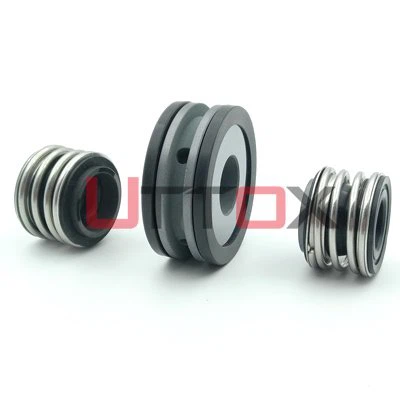Uttox manufactures and sells replacement seals for flygt.
Applicable Flygt Pump Models of This Mechanical Seal:
● 3127(Pump)
● 4440 (Mixer)
● 5530 (Pump)
● 3126.090,181,280&290
* To get the latest prices & more info about replacement seals for flygt, please contact Uttox Mechanical Seals by E-mail or Whatsapp.
● Whatsapp: +86-13656834410
*Related Introduction*
Research Progress of Mechanical Seal Mechanism
For mechanical seals, the hypotheses that form the sealing effect are basically divided into two categories, namely, the surface tension hypothesis and the viscous force hypothesis. The surface tension hypothesis was first proposed by A Brkich. The hypothesis recognizes
The stable and reliable seal between the end faces is mainly the result of surface tension. The end face of the seal is actually not an ideal smooth plane, and a small number of protruding parts are in direct contact. G E Rajakovics used experiments to discuss the view that surface tension is an important factor in sealing. At the same time, objections to the viscous hypothesis are raised: ① Viscosity (mainly refers to the adhesion of liquid and solid surfaces) only works when the gap is 10-9m or less, and does not work in the micron-level sealing gap; ②Viscosity is a dynamic feature, and when the seal is at zero leakage, there is no power in the radial direction
Learning process. Domestic Li Keyong and others also agree with the surface tension hypothesis.
P Basu, E Schwaiger and U W Senfert, etc. believe that the liquid film between the sealing surfaces acts like a soft gasket. The molecular force between liquid molecules increases with the increase in viscosity, and decreases with the increase of the sealing gap. J Digard and M Genhle, etc. in the low-pressure mechanical seal lubricating state
In the experimental study of the condition, it was observed that there is a tension zone in the liquid film. During the sealing operation, the pressure sensor measures the pressure in the phase change zone and the tension in the phase change zone before the liquid film breaks. Based on the fact that there is cavitation and vaporization in the end face, J Digard and M Genhle believe that the formation of multiple surface tension effects of multi-stage air gaps is the main reason for improving the overall sealing ability.
However, the viscous hypothesis represented by E F Boon believes that some liquid molecules are stuck on the sealing surface due to viscosity. This viscous force generated in the sealing gap due to pressure difference can prevent the leakage of the medium. Domestic Zheng Haiquan and Chen Ruzhuo demonstrated the limitations of the surface tension hypothesis from the opposite side: ①The maximum sealing capacity calculated according to the surface tension is too small. For water with a large surface tension, the sealing gap is 1μm in the normal situation. The maximum sealing capacity is less than 0.15MPa. To consider the influence of various factors, the revised value will be smaller. The cause, nature, shape, distribution, etc. of the cavitation phenomenon are not yet clear, and the cavitation phenomenon does not occur when the seal is at rest, so it cannot explain the fact that there is still a high sealing ability at rest; ②The surface tension hypothesis must be Leakage is the prerequisite, once it leaks, it will almost completely lose its sealing ability. Because leakage not only reduces the wetting angle, especially the shape of the meniscus and the corresponding liquid film thickness change in the direction of reducing the sealing ability, the sealing ability will be significantly reduced. This not only cannot explain the actual situation of more or less leakage in general seals, but also cannot explain the sealing ability of multi-face seals with liquid inside and outside the sealing surface.
E Mayer analyzed the position of viscosity in the mechanism of mechanical seals through a large number of experiments. Based on the viscous force hypothesis, people have studied and discussed the lubrication state between the end faces of the mechanical seal. Mayer believes that between the friction pairs of ordinary mechanical seals, the thin liquid film, the Newtonian fluid equation
Lack of effective application conditions. In ordinary mechanical seals, there is always contact between the end faces of the friction pair, forming many gaps that are rarely connected to each other. When the two rings rotate relative to each other, the liquid transfers from one gap to the other gap, until the liquid mass point is reached. Until the end of the gap, the end face of the seal is in a boundary lubrication state. Golubev, Summers-Smith, and domestic Gu Yongquan, Wang Rumei, etc. believe that ordinary mechanical seals in actual operation are generally in a state of mixed lubrication. Hydrostatic pressure effect and hydrodynamic pressure effect play different roles in the process of forming liquid film. However, AO Lebeak pointed out in the article "Waviness Prediction, Measurement, Causes and Effects of End Face Seals" that ordinary end face seals working in aqueous media did not produce hydrodynamic pressure effects, which inevitably led people to the field of mechanical seals. Re-understanding of hybrid lubrication theory that occupies an important position.
It can be seen that the mechanism of mechanical sealing has not yet been recognized by people as a complete sealing theory. Nevertheless, people are still searching tirelessly, because every step of the exploration and the hypotheses or conclusions derived therefrom play an important guiding role in the design, manufacture and application of mechanical seals.
Hot Tags: fs-ml35 flygt pump seal, China, suppliers, manufacturers, factory, customized, buy, quality, pricelist, quotation, low price, made in China, flygt mechanical seal, FS OU45 Flygt Pump Seal, mechanical seal of flygt pump, flygt mechanical seals, Flygt 3153 Mechanical Seal, FS 45 Flygt Pump Cartridge Seal








